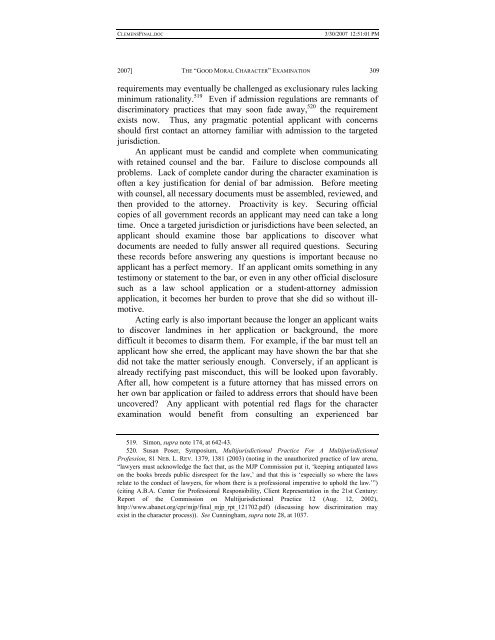Facing the Klieg Lights: Understanding the "Good Moral Character"
Facing the Klieg Lights: Understanding the "Good Moral Character"
Facing the Klieg Lights: Understanding the "Good Moral Character"
Create successful ePaper yourself
Turn your PDF publications into a flip-book with our unique Google optimized e-Paper software.
CLEMENSFINAL.DOC<br />
3/30/2007 12:51:01 PM<br />
2007] THE “GOOD MORAL CHARACTER” EXAMINATION 309<br />
requirements may eventually be challenged as exclusionary rules lacking<br />
minimum rationality. 519 Even if admission regulations are remnants of<br />
discriminatory practices that may soon fade away, 520 <strong>the</strong> requirement<br />
exists now. Thus, any pragmatic potential applicant with concerns<br />
should first contact an attorney familiar with admission to <strong>the</strong> targeted<br />
jurisdiction.<br />
An applicant must be candid and complete when communicating<br />
with retained counsel and <strong>the</strong> bar. Failure to disclose compounds all<br />
problems. Lack of complete candor during <strong>the</strong> character examination is<br />
often a key justification for denial of bar admission. Before meeting<br />
with counsel, all necessary documents must be assembled, reviewed, and<br />
<strong>the</strong>n provided to <strong>the</strong> attorney. Proactivity is key. Securing official<br />
copies of all government records an applicant may need can take a long<br />
time. Once a targeted jurisdiction or jurisdictions have been selected, an<br />
applicant should examine those bar applications to discover what<br />
documents are needed to fully answer all required questions. Securing<br />
<strong>the</strong>se records before answering any questions is important because no<br />
applicant has a perfect memory. If an applicant omits something in any<br />
testimony or statement to <strong>the</strong> bar, or even in any o<strong>the</strong>r official disclosure<br />
such as a law school application or a student-attorney admission<br />
application, it becomes her burden to prove that she did so without illmotive.<br />
Acting early is also important because <strong>the</strong> longer an applicant waits<br />
to discover landmines in her application or background, <strong>the</strong> more<br />
difficult it becomes to disarm <strong>the</strong>m. For example, if <strong>the</strong> bar must tell an<br />
applicant how she erred, <strong>the</strong> applicant may have shown <strong>the</strong> bar that she<br />
did not take <strong>the</strong> matter seriously enough. Conversely, if an applicant is<br />
already rectifying past misconduct, this will be looked upon favorably.<br />
After all, how competent is a future attorney that has missed errors on<br />
her own bar application or failed to address errors that should have been<br />
uncovered? Any applicant with potential red flags for <strong>the</strong> character<br />
examination would benefit from consulting an experienced bar<br />
519. Simon, supra note 174, at 642-43.<br />
520. Susan Poser, Symposium, Multijurisdictional Practice For A Multijurisdictional<br />
Profession, 81 NEB. L. REV. 1379, 1381 (2003) (noting in <strong>the</strong> unauthorized practice of law arena,<br />
“lawyers must acknowledge <strong>the</strong> fact that, as <strong>the</strong> MJP Commission put it, ‘keeping antiquated laws<br />
on <strong>the</strong> books breeds public disrespect for <strong>the</strong> law,’ and that this is ‘especially so where <strong>the</strong> laws<br />
relate to <strong>the</strong> conduct of lawyers, for whom <strong>the</strong>re is a professional imperative to uphold <strong>the</strong> law.’”)<br />
(citing A.B.A. Center for Professional Responsibility, Client Representation in <strong>the</strong> 21st Century:<br />
Report of <strong>the</strong> Commission on Multijurisdictional Practice 12 (Aug. 12, 2002),<br />
http://www.abanet.org/cpr/mjp/final_mjp_rpt_121702.pdf) (discussing how discrimination may<br />
exist in <strong>the</strong> character process)). See Cunningham, supra note 28, at 1037.
















